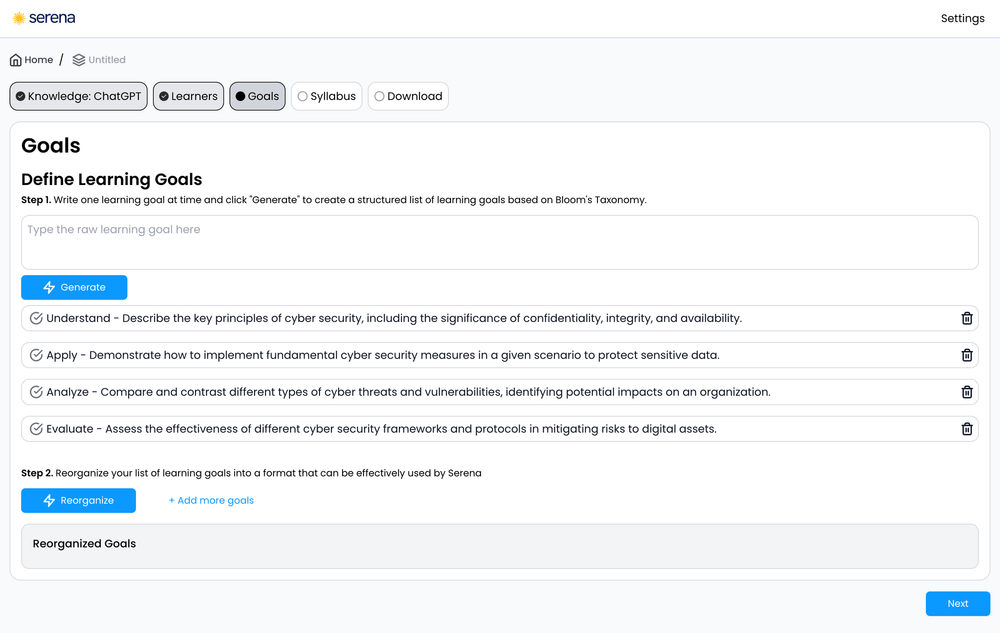How Bloom’s Taxonomy and Serena Help You Create Clear Learning Goals

When designing a course, clear learning objectives are your guiding star. They help both instructors and learners understand the purpose of each lesson and ensure that the course delivers meaningful outcomes. Without well-defined objectives, it’s hard to determine what content to include, how to structure activities, or how to assess progress.
That’s where Bloom’s Taxonomy comes in. This time-tested framework helps instructional designers write learning objectives that are clear, measurable, and progressively challenging. By using Bloom’s Taxonomy, you can ensure your courses move learners from foundational knowledge to advanced problem-solving and creativity, making learning more effective and engaging.
What is Bloom’s Taxonomy?
Developed by Benjamin Bloom and colleagues in 1956 (and revised in 2001), Bloom’s Taxonomy categorizes learning into six levels of cognitive skills, arranged from basic to complex:
- Remember – Recall facts and basic concepts.
- Understand – Explain ideas and concepts.
- Apply – Use knowledge in new situations.
- Analyze – Break information into parts and explore relationships.
- Evaluate – Make judgments based on criteria and standards.
- Create – Generate new ideas or original work.
Think of these levels as steps on a staircase—each step builds on the one before it. Before learners can analyze or evaluate a concept, they need to understand and apply it first. That’s why Bloom’s Taxonomy is often visualized as a pyramid, emphasizing the progression from foundational skills to higher-order thinking.
How Bloom’s Taxonomy Strengthens Course Design
Whether you're creating a short workshop or a full online course, Bloom’s Taxonomy helps you build objectives that make sense and support deeper learning. Here’s why it’s a must-have tool for instructional designers:
1. Creates a Logical Learning Progression
A well-structured course moves learners from simple to complex skills. With Bloom’s Taxonomy, you can sequence learning objectives so early modules focus on foundational knowledge (Remember, Understand), while later modules introduce higher-order thinking (Analyze, Evaluate, Create). This avoids sudden leaps that might confuse learners and ensures a smooth learning journey.
2. Makes Objectives Clear and Measurable
Vague learning goals like "understand project management" don’t provide clear direction. Instead, using Bloom’s framework, you might say: "Define key project management terms" (Remember) or "Evaluate a project plan for risks" (Evaluate). This clarity makes it easier to design assessments that truly measure learning outcomes.
3. Aligns Assessments with Objectives
Your assessments should match the level of cognitive skill you’re targeting. If an objective is "Apply a budgeting strategy to a case study," then a multiple-choice quiz isn’t enough. Instead, a hands-on budgeting exercise makes more sense. Bloom’s Taxonomy ensures that your assessments reflect the learning goals, making evaluation more meaningful.
4. Encourages Higher-Order Thinking
Great courses don’t just ask learners to memorize facts—they challenge them to think critically and solve real-world problems. Bloom’s Taxonomy helps you push beyond rote learning and design activities that encourage analysis, evaluation, and creativity, leading to richer, more engaging learning experiences.
5. Ensures Course Coherence and Flow
When objectives are built using Bloom’s framework, the course naturally follows a logical progression. Early lessons might focus on "describing fundamental concepts" (Understand) and "identifying examples" (Remember), while later ones might require learners to "compare and contrast theories" (Analyze) or "develop a solution for a real-world scenario" (Create). This structured approach helps learners build confidence as they advance through the course.
How Serena uses the Bloom’s Taxonomy

Writing clear learning objectives can feel overwhelming, but Serena makes it easy. By applying Bloom’s Taxonomy, Serena helps instructional designers refine their course learning goals step by step. From turning vague ideas into structured outcomes to organizing objectives into a logical sequence, Serena streamlines the process so you can focus on what matters most—creating great learning experiences.
Step 1: Enter Your Learning Goal
Think of this as your rough draft. In Step 1, type a raw learning goal into the text box—don’t worry about perfecting it! For example, you might start with:
“Understand cybersecurity” (too vague!)
Now, click Generate and let Serena work its magic. Serena will refine your goal into something more precise and measurable, like:
- Understand - Describe the key principles of cyber security, including the significance of confidentiality, integrity, and availability.
- Apply - Demonstrate how to implement fundamental cyber security measures in a given scenario to protect sensitive data.
- Analyze - Compare and contrast different types of cyber threats and vulnerabilities, identifying potential impacts on an organization.
- Evaluate - Assess the effectiveness of different cyber security frameworks and protocols in mitigating risks to digital assets.
These tweaks ensure your learning objectives are specific, actionable, and aligned with real learning progress.
Step 2: Reorganize for Clarity and Flow
Now that you have a list of structured objectives, it’s time to organize them. Click Reorganize, and Serena will arrange your goals into a logical sequence based on Bloom’s levels.
Why is this important? A great course follows a natural learning flow:
- Early modules should focus on foundational knowledge (Remember, Understand).
- Later modules should build on this with application and critical thinking (Analyze, Evaluate, Create).
Conclusions
Designing courses with clear, structured learning objectives doesn’t have to be a daunting task. By leveraging Bloom’s Taxonomy, you ensure that learning progresses logically, assessments align with goals, and students engage in meaningful, higher-order thinking.
Serena takes this a step further—automating the refinement of learning goals, structuring them into a logical sequence, and ensuring that every objective is clear and measurable.
Let’s shape the future of instructional design together. Join the Community.
References:
- Bloom, B. S., & collaborators (1956). Taxonomy of Educational Objectives: The Classification of Educational Goals. (Revised by Anderson, L. W., & Krathwohl, D. R., 2001)
- https://tips.uark.edu/using-blooms-taxonomy/
- https://www.learnworlds.com/learning-objective-generator-ai/
- https://moodle.com/us/news/guide-to-instructional-design/